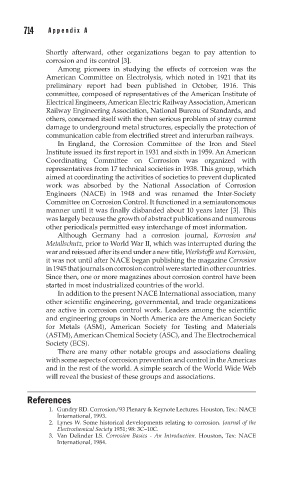Page 763 - Corrosion Engineering Principles and Practice
P. 763
714 A p p e n d i x A
Shortly afterward, other organizations began to pay attention to
corrosion and its control [3].
Among pioneers in studying the effects of corrosion was the
American Committee on Electrolysis, which noted in 1921 that its
preliminary report had been published in October, 1916. This
committee, composed of representatives of the American Institute of
Electrical Engineers, American Electric Railway Association, American
Railway Engineering Association, National Bureau of Standards, and
others, concerned itself with the then serious problem of stray current
damage to underground metal structures, especially the protection of
communication cable from electrified street and interurban railways.
In England, the Corrosion Committee of the Iron and Steel
Institute issued its first report in 1931 and sixth in 1959. An American
Coordinating Committee on Corrosion was organized with
representatives from 17 technical societies in 1938. This group, which
aimed at coordinating the activities of societies to prevent duplicated
work was absorbed by the National Association of Corrosion
Engineers (NACE) in 1948 and was renamed the Inter-Society
Committee on Corrosion Control. It functioned in a semiautonomous
manner until it was finally disbanded about 10 years later [3]. This
was largely because the growth of abstract publications and numerous
other periodicals permitted easy interchange of most information.
Although Germany had a corrosion journal, Korrosion and
Metallschutz, prior to World War II, which was interrupted during the
war and reissued after its end under a new title, Werkstoffe und Korrosion,
it was not until after NACE began publishing the magazine Corrosion
in 1945 that journals on corrosion control were started in other countries.
Since then, one or more magazines about corrosion control have been
started in most industrialized countries of the world.
In addition to the present NACE International association, many
other scientific engineering, governmental, and trade organizations
are active in corrosion control work. Leaders among the scientific
and engineering groups in North America are the American Society
for Metals (ASM), American Society for Testing and Materials
(ASTM), American Chemical Society (ASC), and The Electrochemical
Society (ECS).
There are many other notable groups and associations dealing
with some aspects of corrosion prevention and control in the Americas
and in the rest of the world. A simple search of the World Wide Web
will reveal the busiest of these groups and associations.
References
1. Gundry RD. Corrosion/93 Plenary & Keynote Lectures. Houston, Tex.: NACE
International, 1993.
2. Lynes W. Some historical developments relating to corrosion. Journal of the
Electrochemical Society 1951; 98: 3C–10C.
3. Van Delinder LS. Corrosion Basics - An Introduction. Houston, Tex: NACE
International, 1984.

